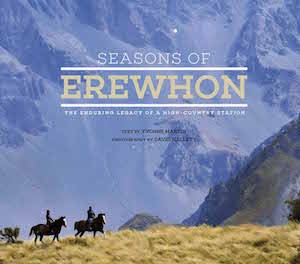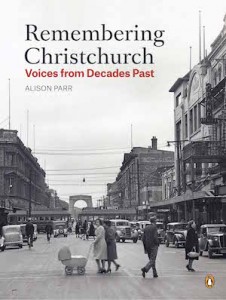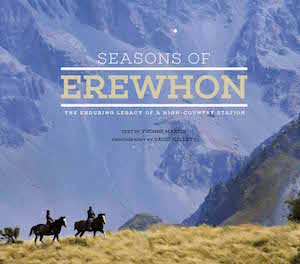When my sister and brother-in-law arrived up in Auckland from Rangiora last week for a summer holiday the rain was pouring down. I left a couple of books about Canterbury on the coffee table for them to peruse while we waited for the sun to come out.
 Seasons of Erewhon
Seasons of Erewhon
Erewhon is a vast mid Canterbury high-country station. Here horses, sheep (and supposedly hobbits) roam and cellular coverage is not available. The stories of the men who it made, but also of those who it broke, are told in this book.
In the late 19th century the station was called Stonecrubie and was owned by a Scottish settler called George McRae. When the farm did not pay its way he mustered for his neighbours leaving his wife to fend for herself for weeks on end in a hut. It lost the sun for about 6 weeks in the dead of winter and had no running water nearby. For five years she did not see another woman!
The Urquhart family successfully farmed it for 52 years from 1943- 1995.
Colin Urquhart, the son of pioneering farmer Arthur Urquhart, spent 50 years at Erewhon. It is still close to his heart.
“It seems to have a similar effect on many who are drawn to these mountains. The grandeur of the landscape that so captured the early settlers continues to lure runholders, shepherds, tourists, photographers, artists and film companies and always will.”
The current owners, Colin Drummond, who dislikes polypropylene thermals, pasta and pretentiousness and his partner Erin Cassie share his passion for the high country and a love of horses.
The book takes us through the seasons, catching the rhythm of what happens at Erewhon during each part of the year.
Autumn is the season for mustering ‘to round up the merino sheep that have been left to graze the tussocky tops and river plains and must be moved to the home paddocks before the winter freeze.”
In winter the paddocks must be ploughed in readiness for the spring planting. Steve Muggeridge, a third generation teamster, sits on a plough behind a team of eight willing Clydesdales. His days are long but he says, “I’d rather sit on a plough for eight hours a day behind a team of eight horses than drive a bloody tractor, that’s for sure.”
And the blade-shearing gang, a dozen strong including a cook, arrive shear the 1700 merinos. They work 7 days a week.
In spring the horses are shampooed, polished and dressed in full show regalia to compete in both the Canterbury and Nelson A&P shows.
When summer comes round “the ewes that were blade-shorn in August now have plump lambs at foot. The sheep have been brought in for dipping, drenching and checking for foot rot. The lambs face the extra indignity of ear clipping, castration and railing.”
The main business of Erewhon is still the production of merino wool for the top brand Icebreaker. But because of the economic climate they have had to diversify to keep the farm viable. Tourism has become a growing part of their business.
They are flocking to Erewhon, to see the farm in action and to view nearby Mt Sunday on which the mythical Edoras, the capital of Rohan in the Lord of the Rings movie, stood. For anyone who is planning to take a journey there, as well as those who have already been, this book will be a treasure to peruse and keep.
My brother-in-law Alan found it a really good read. He went to King’s College boarding school with Colin Urquhart and until his recent retirement had his own farm in Hawarden. This personal connection and his knowledge of the farming life made Erewhon of special interest to him also.
Title: Seasons of Erewhon. Author: Yvonne Martin and David Hallett. RRP $65 Imprint: Penguin NZ
 Remembering Christchurch
Remembering Christchurch
So many sad stories were published after the devastating Christchurch earthquake that I have become somewhat resistant to reading more of them as they are so depressing.
But Remembering Christchurch is different. Although the citizens who feature in it were badly affected by the quake and many lost their family homes and workplaces it is not a gloomy book. It is a rich tapestry of precious memories of how life was lived in Christchurch before the quake.
In Remembering Christchurch author and oral historian Alison Parr was keen to record the living legacy of a diverse group of elderly people from different parts of the city including Lyttelton, Dallington, Addington, New Brighton and Woolston
The 19 participants, all elderly and born during the 20’s, 30’s and 40’s tell of how life was lived in their younger years. There were tough times during the depression and World War Two but young people still made their own fun, went to movies, milkbars and pie carts and danced and cycled around the city.
It makes for an interesting piece of social history in which the different attitudes to class, race, religion, sex and the place of women emerge.
Lauren Small (born 1930) who now lives in a retirement village after the earthquakes severely damaged their home remembers growing up in Rose St, Spreydon. To keep in touch with her boyfriend (and husband to be who she met when he was 15 yrs. old), “We never had the telephone on at home but there was a red telephone box just at the corner of the lamp post by the park. I rang Bob because he had the phone on at his home and I’d have to put a penny in the slot and ring him.”
Joan Lydon (born 1929) used to cycle everywhere when she was young. “No-one had a car. So we cycled all over the place, and always with lots of company and parties and things like that.”
Christchurch was called ‘A city on Wheels.’
Richard Cottrell (born 1936) whose Father was an All Black attended Kings’ College when there was caning and fagging by prefects. When he got to be a prefect he could send his fags to get him an ice-cream, clean his football boots, keep his hair tidy and make his bed.” After he got engaged to Vi Markham who was tall and dark and rather beautiful his mother was deeply shocked when she caught them holding hands in Cathedral Square.
Malcolm Douglass (born 1932) spent his student days at the University of Canterbury when it was located in the old stone buildings between Worcester Boulevard and Hereford Street. He studied civil engineering which in those days was still a male preserve. They got up to the usual student pranks including occasionally scaling the roofs of the old university building at night. It was part of their climbing experience!
“We knew the way up onto those roofs. We’d go in sandshoes in those days and you’d take a rope with you. You could navigate right round the roof of the college with little care.
Doug Couch (Ngai Tahu, born 1932) grew up in Rapaki, an ancient Maori settlement on Lyttleton Harbour/Whangaraupo overlooked by the rocky peak. He grew up during World War Two. His Mum was known as Mother Cream Cakes. She loved making cream sponges which she made in the oven of the coal range and was known for her food when there was anything on at the marae. “She used to whip up the butter, make her own butter.” Ordinary butter was rationed during the war.
Reg Millar (born 1929) worked for 50 years in his family’s manufacturing and retail business. He remembers how tough times were during the depression. “It was very, very difficult. My father…he used to have to go around the tills, particularly at the end of the day, to scrape out enough money to pay the wages. It wasn’t easy.”
Baden Norris (born 1927) was a child of the Depression and left school at 13 to work in a boot factory. At the beginning of World War Two he joined the EPS-Emergency Precautions Scheme – practices where you had mock air raids and aircrafts flying more or less at Mast height. His job was to be a dispatch rider and was ordered to deliver some messages on his bike.
“I remember going down Oxford Street to deliver some messages and this damned Harvard aircraft came along. I’m sure it would have knocked my head off if I hadn’t hunched. It gave me the fright of my life, straight down Oxford Street-Brrrmmm! Very realistic.”
Sadly, the participants will not be around to see the rebuild of Christchurch completed. Two of them have already died since the book was published. But their stories will remain as a precious legacy for future generations.
My sister who has lived in Canterbury for most of her life thought this book would appeal most to those who live there, especially if they know one of the people whose history is recorded in this book.
Title: Remembering Christchurch. Author: Alison Parr. RRP $45.00 Imprint: Penguin.
By Lyn Potter. Read more here.









Join the Discussion
Type out your comment here:
You must be logged in to post a comment.